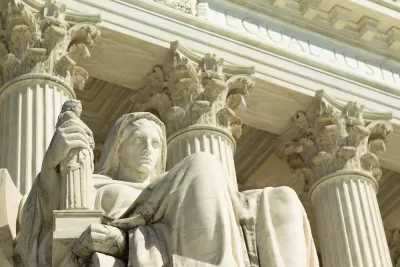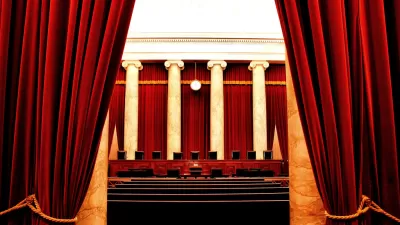Summarizes Justice Scalia's most important Takings Clause decisions.

Since Justice Antonin Scalia passed away a few days ago, the media has been full of articles on Justice Scalia's work; however, I have seen very little discussion of his land use legacy. It seems to me that two of his Takings Clause opinions are especially noteworthy.
In my first-year property class, I nearly always teach Scalia's majority opinion in the case of Lucas v. South Carolina Coastal Council. State government prohibited the Lucas plaintiff from developing his land. The plaintiff claimed that the state had taken the property in question, and thus was required to compensate him under the Takings Clause of the Fifth Amendment.
Even before Lucas, it was well settled that a government regulation could constitute a taking when it had gone "too far." However, pre-Lucas decisions had often been unclear about how far is "too far." Scalia sought to clarify this question by writing that a land use regulation is always a taking if it "denies all economically beneficial or productive use of land." He reasoned that such deprivation is "from the landowner’s point of view, the equivalent of a physical appropriation" because if a landowner cannot profit from land, there isn't much point in owning it. Moreover, most regulation is designed to assure an "average reciprocity of advantage to everyone concerned"—but no such reciprocity exists when government imposes such a huge loss upon the landowner.
I use Lucas to explain that the Takings Clause imposes at least one seemingly clear limit on government regulation: that government cannot make your land worthless and undevelopable. I then use other cases to show the limits of this principle. As a practical matter, government regulation rarely eliminates all "economically beneficial or productive use of land," even when it reduces a parcel’s resale value by 90 percent. So although the Lucas decision is conceptually interesting, it had more bark than bite. Takings cases involving partial deprivation of value are usually governed by a balancing test that weighs a variety of factors, rather than by a categorical rule.
A second major Scalia decision is Nollan v. California Coastal Commission. In Nollan, the plaintiffs sought to build a three-bedroom house on a California beach. State bureaucrats were willing to grant them a permit, but only if they allowed a public easement across their property to the beach.
Justice Scalia, writing for the Court, began by stating that if the state had ordered the plaintiffs to create an easement for the public, this easement would undoubtedly have been a taking of plaintiffs' land. On the other hand, if the state had denied a permit to the plaintiffs, this might not be a taking, because the government had the power to forbid construction to serve public goals (such as protecting the public’s view of the beach). So was the condition more like a (prohibited) easement or a (permitted) development limit?
Scalia split the difference, holding that a permit condition was valid if it was "reasonably related to the public need or burden that the [plaintiffs’] new house creates." He found that this was not the case in Nollan, because the public harm caused by the house, if any, was "obstacles to viewing the beach"—a problem that would not be solved by making it easier for people already on the beach to walk across the plaintiffs' property. By contrast, if the state had imposed a condition "that would have protected the public’s ability to see the beach notwithstanding construction of the new house—for example, a height limitation, a width restriction, or a ban on fences… imposition of the condition would also be constitutional."
At first glance, Nollan seems so fact-specific as to be unimportant. But in later cases, the Supreme Court expanded upon Nollan, holding that it required permit conditions to be roughly proportional to the impact of a proposed land use, and that this rule applies not just to conditions upon building permits, but to conditions used to justify denial of permits, and to conditions requiring applicants to spend money. In other words, if you want a rezoning, and the government says "we will grant your rezoning only if you do X," X has to related to, and be roughly proportional to, the externalities (e.g. traffic congestion) caused by your rezoning.

Alabama: Trump Terminates Settlements for Black Communities Harmed By Raw Sewage
Trump deemed the landmark civil rights agreement “illegal DEI and environmental justice policy.”

Planetizen Federal Action Tracker
A weekly monitor of how Trump’s orders and actions are impacting planners and planning in America.

The 120 Year Old Tiny Home Villages That Sheltered San Francisco’s Earthquake Refugees
More than a century ago, San Francisco mobilized to house thousands of residents displaced by the 1906 earthquake. Could their strategy offer a model for the present?

In Both Crashes and Crime, Public Transportation is Far Safer than Driving
Contrary to popular assumptions, public transportation has far lower crash and crime rates than automobile travel. For safer communities, improve and encourage transit travel.

Report: Zoning Reforms Should Complement Nashville’s Ambitious Transit Plan
Without reform, restrictive zoning codes will limit the impact of the city’s planned transit expansion and could exclude some of the residents who depend on transit the most.

Judge Orders Release of Frozen IRA, IIJA Funding
The decision is a victory for environmental groups who charged that freezing funds for critical infrastructure and disaster response programs caused “real and irreparable harm” to communities.
Urban Design for Planners 1: Software Tools
This six-course series explores essential urban design concepts using open source software and equips planners with the tools they need to participate fully in the urban design process.
Planning for Universal Design
Learn the tools for implementing Universal Design in planning regulations.
Clanton & Associates, Inc.
Jessamine County Fiscal Court
Institute for Housing and Urban Development Studies (IHS)
City of Grandview
Harvard GSD Executive Education
Toledo-Lucas County Plan Commissions
Salt Lake City
NYU Wagner Graduate School of Public Service






























